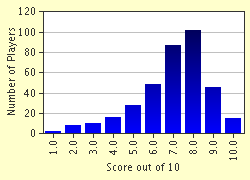Quiz Answer Key and Fun Facts
1. The principal languages of the USSR consisted of Russian, Ukrainian, Belorussian, Georgian, Armenian, and what other language?
2. The USSR bordered on twelve foreign states. What two foreign states immediately bordered the USSR to the North West?
3. After May 14, 1955, the USSR were allied to seven other states of Eastern Europe. What was the name of this military alliance?
4. Economically, the most important Russian river is the ______ River?
5. What body of water was the largest fresh water lake in the USSR?
6. What was the capital of the USSR?
7. What was the most famous Russian art museum?
8. When was the last version of the Soviet constitution adopted?
9. Next to the Politburo of the Communist Party, what was the most important policy-making body in the USSR?
10. Ivan IV (reigned 1533-84) was also known by what other name?
Source: Author
LizardFuel
This quiz was reviewed by FunTrivia editor
bloomsby before going online.
Any errors found in FunTrivia content are routinely corrected through our feedback system.

